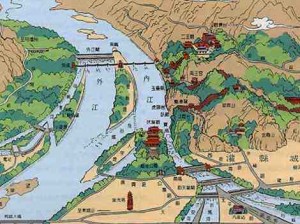Finally, after three and a half centuries of great turmoil, the empire finally reconvenes—first during the short-lived SUI dynasty, then the more famous and enduring TANG dynasty.
The Sui Dynasty [581-618]
The Sui dynasty is often compared to the Qin, since they were both short-lived with iron-fisted rulers who forced huge chunks of the population into massive projects.
The Sui dynasty sets up their capital at Chang’an (Xi’an), which has been preferred capital for last 16 centuries by almost a dozen dynasties up to this point.
One persistent problem with Chang’an: it’s poorly located, requiring food and supplies to be transported far from the south. The solution?
The Grand Canal
An ambitious project rivaling the Great Wall in magnitude, the Grand Canal provided an unbroken inland transport between the Yellow and Yangzi rivers. At its peak, it was over 2,000km long—linking five river systems—and extended from Beijing and Hangzhou (over 1000km/640miles away). Many parts are still in use today.
Although the canal network would increase trade, wealth, and integration, it sowed the seeds of the Sui’s downfall. Apparently they didn’t learn from the Qin. Some 5.5 million were conscripted to work on it. Another million or so were sent to restore the Great Wall. Not surprisingly, the people were NOT happy.
Another One Bites The Dust
The megalomaniacal Emperor Yang—considered one of worst rulers in Chinese history—was a classic example of two-generation Good first ruler, Bad last ruler dilemma.
Following a period floods and famine, the people decide that enough is enough. Rebellion engulfs the country. Yang is assassinated in Chengdu—strangled by the son of a previously disgraced minister (“Hello. My name is Inigo Montoya. You disgraced my father. Prepare to die.”).
A popular Sui general, Li Yuan, steps up to the plate and declares the start of a new dynasty: the TANG (no relation to the Wu Tang Clan).
The Tang Dynasty [ 618-907 ]
The Tang is widely regarded as the height of imperial China. Economically, territorially, and socially, the Tang was firing on all cylinders. China reached its largest size up to this point in history—reaching Korea, Vietnam and much of Central Asia. Trade flourished by land and sea. Some of China’s finest arts and literature also came out of the Tang.
The Tang also holds the unique distinction of having China’s only female to hold the title of emperor (actually, Empress, Wu), who historians regard as brilliant but ruthless.
An Open, Tolerant Dynasty
The Tang was open to foreign cultures and religions, including Christianity. They established frequent cultural exchanges with many neighboring countries. For example, Japan and Korea sent “emissaries to the Tang” to Chang’an to study Chinese culture. These exchanges would heavily influence the development of their political, economic and social systems.
Chang’an became one of the richest, largest, and most cosmopolitan in the world—Indian, Central Asian and Middle Eastern traders mingled on its streets. At its peak, it had an estimated million inhabitants, including about 20,000-50,000 foreigners.
652: The Great Wild Goose Pagoda is constructed (still stands today in Xi’an). It was built specifically to store a large number of Buddhist texts that were brought from India by the famous monk Xuan Zhang, who traveled there for 17 years. His adventures were the subject of the Journey to the West (another of the “Four Great Classical Novels”) and the source of many Chinese operas.
Fabric weaving and paper-making technologies spread via the Arabs to Western Asia and Europe.
Woodblock printing is invented during the 7th century, hastening the spread of Buddhism.
The Tang dynasty ended with a climatic episode, known as the An Lushan Rebellion.
Five Dynasties & Ten Kingdoms [907-960]
After fall of Tang, China lapsed into a brief period of tangled warfare. The north was again ruled by the semi-nomadic people from the steppe region (who would later have a greater impact on Chinese history). And the south was ruled by rival Han Chinese states, which existed in relative peace before being reunited by the SONG.









![The Yuan Dynasty [1279-1368 ]](https://www.china-mike.com/wp-content/uploads/2011/01/Khubilai-khan-small.jpg)
![The Ming Dynasty [1368-1644 ]](https://www.china-mike.com/wp-content/uploads/2011/01/ming-dynasty-map-small.jpg)
![THE SONG DYNASTY [960-1279 ]](https://www.china-mike.com/wp-content/uploads/2011/01/song-dynasty-Bianjing-city-gate-small.jpg)